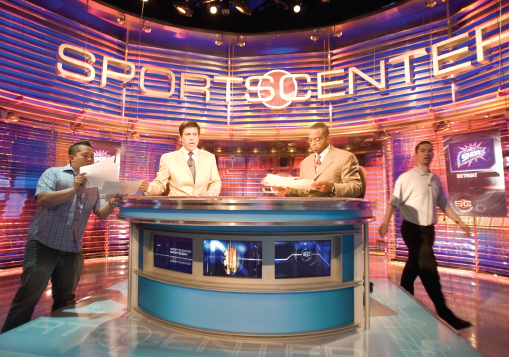Case Study
CASE STUDY
ESPN: Sports and Stories
A common way many of us satisfy our cultural and personal need for storytelling is through sports: We form loyalties to local and national teams. We follow the exploits of favorite players. We boo our team’s rivals. We suffer with our team when the players have a bad game or an awful season. We celebrate the victories.
The appeal of following sports is similar to the appeal of our favorite books, TV shows, and movies—we are interested in characters, in plot development, in conflict and drama. Sporting events have all of this. It’s no coincidence, then, that the Super Bowl is annually the most watched single TV show around the world.
One of the best sports stories on television over the past thirty years, though, may not be a single sporting event but the tale of an upstart cable network based in Bristol, Connecticut. ESPN (Entertainment Sports Programming Network) began in 1979 and has now surpassed all the major broadcast networks as the “brand” that frames and presents sports on TV. In fact, cable operators around the country regard ESPN as the top service when it comes to helping them “gain and retain customers.”1 One of ESPN’s main attractions is its “live” aspect and its ability to draw large TV and cable audiences—many of them young men—to events in real time. In a third-screen world full of mobile devices, this is a big plus for ESPN and something that advertisers especially like.
Today, the ESPN flagship channel reaches more than 100 million U.S. homes. And ESPN, Inc., now provides a sports smorgasbord—a menu of media offerings that includes ESPN2 (sporting events, news, and original programs), ESPN Classic (historic sporting events), ESPN Deportes (Spanish-language sports network), ESPN HD (a high-definition channel), ESPN Radio, ESPN The Magazine, ESPNEWS (twenty-four-hour sports news channel), ESPN Outdoors, and ESPNU (college games). ESPN also creates original programming for TV and radio and operates ESPN.com, which is among the most popular sites on the Internet. Like CNN and MTV, ESPN makes its various channels available in more than two hundred countries.
Each year, ESPN’s channels air more than five thousand live and original hours of sports programming, covering more than sixty-five different sports. In 2002, ESPN even outbid NBC for six years of NBA games—offering $2.4 billion, which at the time was just over a year’s worth of ESPN revenues. But the major triumph of ESPN over the broadcast networks was probably wrestling the Monday Night Football contract from its sports partner, ABC (both ESPN and ABC are owned by Disney). For eight years, starting in 2006, ESPN agreed to pay the NFL $1.1 billion a year for the broadcasting rights to MNF, the most highly rated sports series in prime-time TV history. In 2006, ABC turned over control of its sports programming division, ABC Sports, to ESPN, which now carries games on ABC under the ESPN logo.
The story of ESPN’s “birth” also has its share of drama. The creator of ESPN was Bill Rasmussen, an out-of-work sports announcer who had been fired in 1978 by the New England Whalers (now the Carolina Hurricanes), a professional hockey team. Rasmussen wanted to bring sports programs to cable TV, which was just emerging from the shadow of broadcast television. But few backers thought this would be a good idea. Eventually, Rasmussen managed to land a contract with the NCAA to cover college games. He also lured Anheuser-Busch to become cable’s first million-dollar advertiser. Getty Oil then agreed to put up $10 million to finance this sports adventure, and ESPN took off.
Today, ESPN is 80 percent owned by the Disney Company, while the Hearst Corporation holds the other 20 percent interest. The sports giant earned over $10 billion in worldwide revenue in 2012 and ESPN’s cable ad sales and higher subscription fees were major reasons why Disney’s net income rose to more than $42 billion in 2012. 
